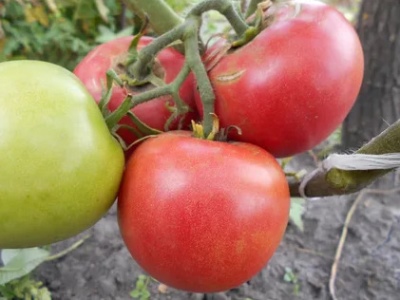
- Authors: Botyaeva G.V., Dederko V.N.
- Year of approval: 2012
- Category: grade
- Growth type: indeterminate
- Appointment: fresh consumption
- Ripening period: mid-season
- Ripening time, days: 109-115
- Growing conditions: for open ground, for greenhouses
- Bush height, cm: 150-180
- Branchiness: medium
The Siberian apple is one of those rare varieties of tomatoes that produce a good harvest in any conditions, even in cool and rainy summers. The culture received this name because of the strong similarity of beautiful pink-pearl fruits with the famous fruit. Mostly tomatoes are grown in greenhouses, but gardeners in the southern regions can afford to plant plants in the fresh air.
Breeding history
The well-known Novosibirsk breeders GV Botyaeva and VN Dederko set themselves the task of creating a tomato variety that will successfully bear fruit primarily on the territory of Siberia with its climatic features. This is how the Siberian apple was obtained, and in 2012 it was entered in the State Register and approved for growing on private farms under film.
Description of the variety
The Siberian apple is an indeterminate type of tomato that reaches not too impressive one and a half meters heights, but sometimes it can grow up to 1.8 meters. Not very branched bushes have medium foliage. But at the same time, the foliage itself is large, green in color. It differs in the presence of simple inflorescences, there is no articulation on the stalk.
The main qualities of the fruit
The main feature of culture is, of course, its fruits. In accordance with the name, they are very similar to an apple, the same round, smooth. However, there is some presence of weak ribs in the form. They are colored in an immature state in a light green tone, and there is no spot at the base. Ripe tomatoes of a beautiful pink color.
By weight, they are also quite similar to a fruit, each fruit weighs about 140 grams, but there are also larger specimens, up to 200 g. The number of seed nests is from 4 to 6. Fruits are well preserved both on the bush and after removal. Transportation is possible without loss of appearance and taste.
Taste characteristics
Great taste is noted by most people who have tried the product. Professional tasters gave a rating of 4.8 points out of 5. Tomatoes are very fleshy, dense, vegetables have a significant sugar content (3.5%), as well as vitamin C (14 mg /%). Basically, the purpose of tomatoes is salad.
Ripening and fruiting
After the first shoots of seeds, the ripening of tomatoes can be expected on day 115. This means that the Siberian apple belongs to the mid-season varieties.
Yield
Basically, the crop is characterized as fruitful. So, on average, the number of ripe marketable tomatoes per 1 m2 of plantation can range from 8.2 to 9 kilograms.
The timing of planting seedlings and planting in the ground
The Siberian apple variety is grown in seedlings. Seeds are sown 50-60 days before the transfer of the grown seedlings to a permanent place. For good germination of seed, it is necessary to maintain the temperature in the room where it is grown at a level of 23-25 degrees.

Growing tomato seedlings is an extremely important process, because it largely depends on whether the gardener can harvest at all. All aspects must be taken into account, from seedbed preparation to planting in the ground.
Landing scheme
When planting in the ground, no more than 3 Siberian apple plants are placed on one square meter.The holes should be about 10 cm deep. Between two plants in a row, a distance of 70 cm should be maintained, in the row spacing - 30-40 cm. In a different arrangement, the varietal tomato will not develop well, the bushes will begin to deform and may even dry out.

Growing and caring
The variety is recommended for cultivation in greenhouses or outdoors. Culture requires shaping and tying to a support or trellis. The variety is grown in 1-2 stems, performing pinching. To strengthen the main branches, remove the lower leaves.
The Siberian apple responds well to fertilizing with mineral and organic fertilizers, as well as to timely watering. Mullein and bird droppings are used only diluted with water (ratio 1: 10). Ready-made preparations, such as "Gumisol" or "Gumi-Plus", are added to the root.




A plant needs different micronutrients at each stage of growth. All fertilizers can be divided into two groups: mineral and organic. Folk remedies are often used: iodine, yeast, bird droppings, eggshells.
It is important to observe the rate and period of feeding. This also applies to folk remedies and organic fertilizers.



























































































